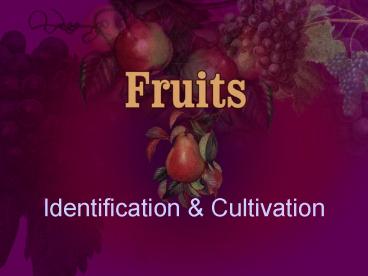Identification - PowerPoint PPT Presentation
1 / 22
Title:
Identification
Description:
Identification & Cultivation. VINE FRUITS. CHAPTER 27. The Grape and Kiwi. Grape history ... Grape seeds produce wild-type. Purchasing. Largest one-year-old vines ... – PowerPoint PPT presentation
Number of Views:48
Avg rating:3.0/5.0
Title: Identification
1
- Identification Cultivation
2
VINE FRUITS CHAPTER 27
- The Grape and Kiwi
3
Grape history
- Oldest cultivated fruit
- Egyptians 3000 BC
- France, Spain, Germany
- Eastern America Vitis labrusca and Vitis riparia
4
Other grapes
- Muscadine from Maryland to Florida
- Concord from Concord Mass. Mid 1800s by Ephraim
Bull
5
California grapes
- Vitis vinifera
- Many other cultivars of red, white and blue
6
Climate
- Limiting factor
- Need 150 continuous frost-free days
- Few varieties in 120 days
7
Propagation
- Hardwood cuttings taken in early spring
- Layering
- Softwood cuttings
- Grape seeds produce wild-type
8
Purchasing
- Largest one-year-old vines
- Choose cultivars hardy to your zone
- Choose for table use, juice or wine-making
9
Planting
- Zones 3 or 4 plant in heat pockets, protected
areas - Trap sunshine, protect against wind
- Light sandy soils
- Create your own heat trap, mulch, crushed rock,
plastic
10
Support systems
- Kniffin system two wired fence
- Needs annual pruning for fruit production and air
circulation
11
First year
- Spring planting
- Blossom later than fruit trees
- Do not overfertilize
- Plant 8 feet apart with a post midway between
- Rows should be 8 feet apart
- Use 9 gauge wire first one 2 feet above ground, 2
feet higher for top
12
First year
- Plant should be cut back to 5-6 inches tall and
contain 2-3 fat buds, if bought bare root - Potted vines omit cutting back
- Water at least 1 inch per week
13
Second year
- Before buds swell, dormant plant, cut the vine
back to a single stem, no branches, encourages
faster growth - Allow 4 side branches to grow, two in each
direction, train them, pinch off other buds. - Will produce in the third year
14
Third year
- Allow only 4 canes to grow from buds
- Train them to grow along the ground, to replace
the ones on the wires. - Late winter, cut top vines off and replace with
new ones
15
Production
- Each vine will produce 12-15 pounds of grapes
(30-60 bunches per year) - Remove surplus to avoid overbearing, weakening
the vine
16
Maintenance
- Keep weed-free
- Needs a warm soil
- Apply fertilizer only vines appear to need it and
early in season
17
Pollination
- Self-fruitful
- Cross pollination not necessary
- Brighton is an exception needs a partner
18
Harvesting
- Ripe grapes have brown seeds
- Full color and bloom, clusters separate easily
from vines - They will not continue to ripen after picking
- Do not let them freeze
- Pick on a dry day, wet grapes do not keep
19
Diseases
- Anthracnose
- Black Rot
- Dead Arm
- Downy mildew
20
Insects
- Japanese beetle
- Cutworms
- Flea beetles
- Grape berry moths
- Rootworms
- Thrips
21
Prevention
- Keep grapes picked
- Encourage birds
- Remove all prunings
- Use insect traps
22
Conclusion
- Grapes are easier than most people think
- Get them trained and there will be less work































